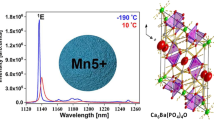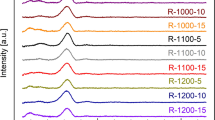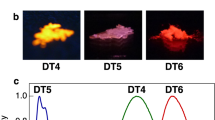Abstract
STRONG room temperature phosphorescence studies of certain doped solid systems1–4 have shown that the characteristic phosphorescence peak wavelengths agree with those established for the corresponding dopants dissolved in 77K systems; the room temperature lifetimes being smaller by a factor of 1.5–2, depending upon the nature of the matrix. We have recently observed an unusual new phenomenon—a weak afterglow from certain of the dopant compounds including carbazole, dibenzothiophene, dibenzofuran and triphenylene when examined as pure crystalline solids. This weak afterglow has different peak wavelengths and lifetimes, but in dilute solid solution form in room temperature resin systems there is no trace of the weak afterglow properties. Melting and resolidification of these pure aromatic compounds do not affect the weak afterglow, and, after vacuum sublimation of carbazole, the afterglow is still observed from the purified product. We believe that we can rule out an impurity effect and this view is reinforced as the afterglow intensifies after recrystallisation from ethanol. As the crystals probably improve on recrystallising, the crystal quality may play a role in this phenomenon.
This is a preview of subscription content, access via your institution
Access options
Subscribe to this journal
Receive 51 print issues and online access
$199.00 per year
only $3.90 per issue
Buy this article
- Purchase on Springer Link
- Instant access to full article PDF
Prices may be subject to local taxes which are calculated during checkout
Similar content being viewed by others
References
Morantz, D. J., Bilen, C. S. & Thompson, R. C. in Reactivity of Solids (eds. Wood, J., Lindqvist, O., Helgesson, C. & Vannerberg, N.-G.) 499–503 (Plenum, New York, 1977).
Bilen, C. S. & Morantz, D. J. Polymer 17, 1091–1094 (1976).
Bilen, C. S. & Morantz, D. J. Nature 258, 66–67 (1975).
Morantz, D. J., Bilen, C. S. & Harrison, N. Int. Conf. on Radiationless Processes, Breukelen (1977).
Martin, T. E. thesis, Univ. London (1966).
Berlman, I. B. Handbook of Fluorescence Spectra of Aromatic Molecules 2nd edn. (Academic, New York, 1971).
Birks, J. B. & Christophorou, L. G. Spectrochim. Acta 19, 401 (1963).
Author information
Authors and Affiliations
Rights and permissions
About this article
Cite this article
BILEN, C., HARRISON, N. & MORANTZ, D. Unusual room temperature afterglow in some crystalline organic compounds. Nature 271, 235–237 (1978). https://doi.org/10.1038/271235a0
Received:
Accepted:
Published:
Issue Date:
DOI: https://doi.org/10.1038/271235a0
This article is cited by
-
Axially chiral materials exhibiting blue-emissive ultralong organic phosphorescence and intense circularly polarized luminescence
Science China Materials (2023)
-
Recent advances in room-temperature phosphorescent materials by manipulating intermolecular interactions
Science China Chemistry (2023)
-
Carbazole isomers induce ultralong organic phosphorescence
Nature Materials (2021)
-
Room-temperature phosphorescence from organic aggregates
Nature Reviews Materials (2020)
-
Enhancing the performance of pure organic room-temperature phosphorescent luminophores
Nature Communications (2019)
Comments
By submitting a comment you agree to abide by our Terms and Community Guidelines. If you find something abusive or that does not comply with our terms or guidelines please flag it as inappropriate.



